If you’re looking for an easy way to give your brick fireplace a fresh new look, whitewashing is the perfect option! In this article, we will answer some of the most common questions about whitewashing a brick fireplace. We’ll also provide some helpful tips to make the process go as smoothly as possible. So if you’re ready to give your fireplace a quick and easy makeover, keep reading!
Step 1: Clean The Brick Gently And Thoroughly
Trisodium Phosphate
Before you start whitewashing your fireplace, it’s important to clean the brick gently and thoroughly. You don’t want any dirt or grime to interfere with the whitewash process. One of the best ways to clean brick is with trisodium phosphate (TSP).
To use TSP on your fireplace, mix one part TSP with four parts water. Use a sponge or brush to apply the mixture to the brick surface. Let it sit for a few minutes before scrubbing gently with a nylon brush. Rinse the area well with water and let it dry completely before moving on to the next step.
Ammonia
The first step in whitewashing a brick fireplace is to clean the surface of the bricks. You’ll want to use a gentle cleaner that won’t damage the bricks. We recommend using an ammonia-based cleaner for this task.
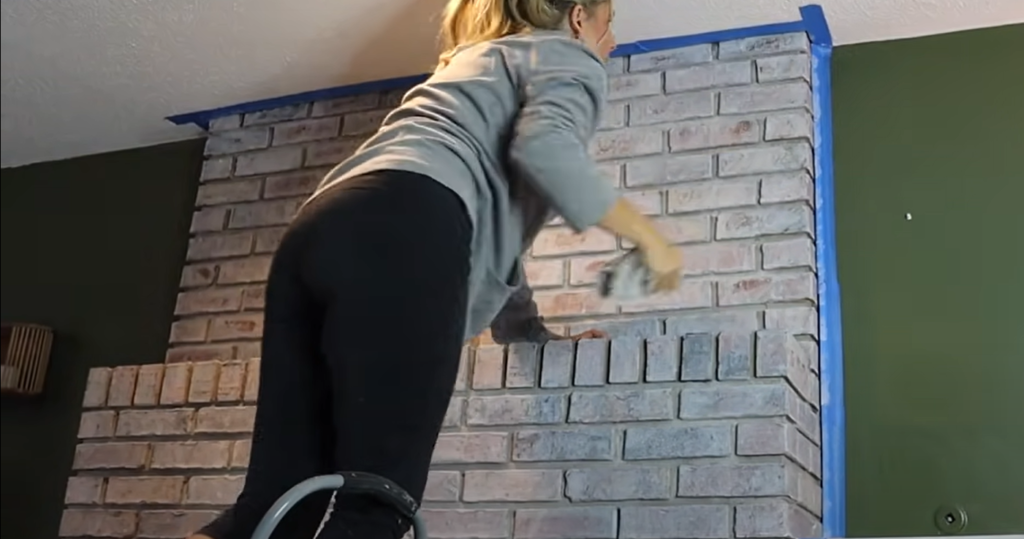
Ammonia is a powerful cleaning agent that will remove any soot or dirt from the bricks. Just be sure to follow the manufacturer’s instructions carefully and wear gloves and a mask when working with it.
Dish Soap
The first step in whitewashing your brick fireplace is to give it a good cleaning. You don’t need to use any harsh chemicals or scrub too vigorously. A simple solution of dish soap and water will do the trick.
If your fireplace is particularly dirty, you may need to pre-treat it with a degreaser or all-purpose cleaner before washing with soap and water. Just be sure to read the labels carefully and follow the instructions carefully. You don’t want to damage your bricks by using too strong of a cleaner.
Boric Acid
When it comes to whitewashing a brick fireplace, one of the most important ingredients is boric acid. This substance is key in helping to create the perfect white color that you’re looking for. Boric acid can be found at most hardware stores, and it’s important to follow the directions on the package when using it. Once you have your boric acid, mix it with water according to the package directions. Then, use a brush to apply the mixture to your brick fireplace. Allow the mixture to dry completely before moving on to the next step.
Step 2: Remove All Lingering Paint (Optional)
If your fireplace has been previously painted, you’ll want to remove as much of the old paint as possible before beginning your whitewashing project. To do this, you can use a paint stripper or a heat gun. Be sure to follow the instructions on whichever product you choose, and always wear gloves and proper safety gear when working with chemicals or high temperatures.[1]
Step 3: Protect The Work Area
Now that you’ve decided on the perfect whitewash for your fireplace, it’s time to prepare the work area. This will help ensure a smooth application and prevent any unwanted accidents.
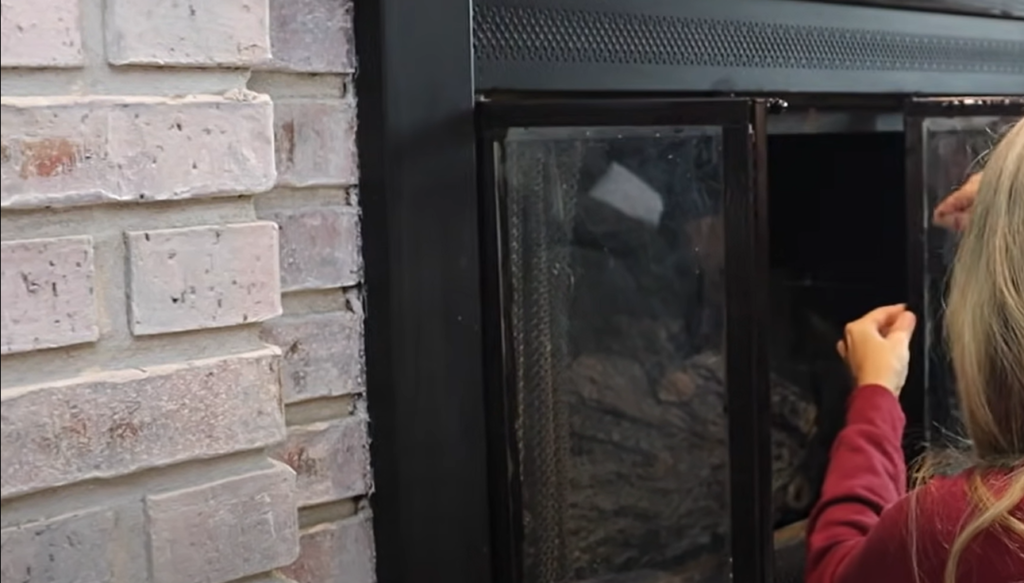
To start, lay down some old towels or rags around the fireplace. This will catch any drips or spills during the whitewashing process. Next, use painters’ tape to secure plastic sheeting over the floor and any surrounding surfaces that you don’t want to get paint on.
Step 4: Prepare The Whitewash
The whitewash solution is simply white paint mixed with water. You’ll want to mix the two together until you have a thin consistency – think milk or heavy cream. Once you have your whitewash mixture, it’s time to get started!
Step 5: Apply Whitewash
Now that your brick is clean and prepped, it’s time to apply the whitewash. To do this, you’ll need a large brush (a paintbrush will work fine) and a bucket of whitewash.
Start by dipping your brush into the whitewash. Then, start painting the whitewash onto the bricks in long, even strokes. Work from top to bottom, and be sure to evenly coat all sides of each brick. As you work, keep an eye out for any areas that seem to be absorbing more whitewash than others; these areas will need a second coat.
Once you’ve finished applying the whitewash, allow it to dry for 24 hours before moving on to the next step.
Common Methods To Whitewash Brick Fireplaces
German Smear
The German smear is a popular method for whitewashing brick fireplaces. This technique involves applying a thin layer of mortar to the bricks using a putty knife. Once the mortar has been applied, it is then smoothed out using a damp sponge.
One advantage of the German smear method is that it can be easily customized to create different looks. For example, you can add more or less mortar to create a more textured or smooth finish. Additionally, this method is relatively easy and does not require any special equipment.
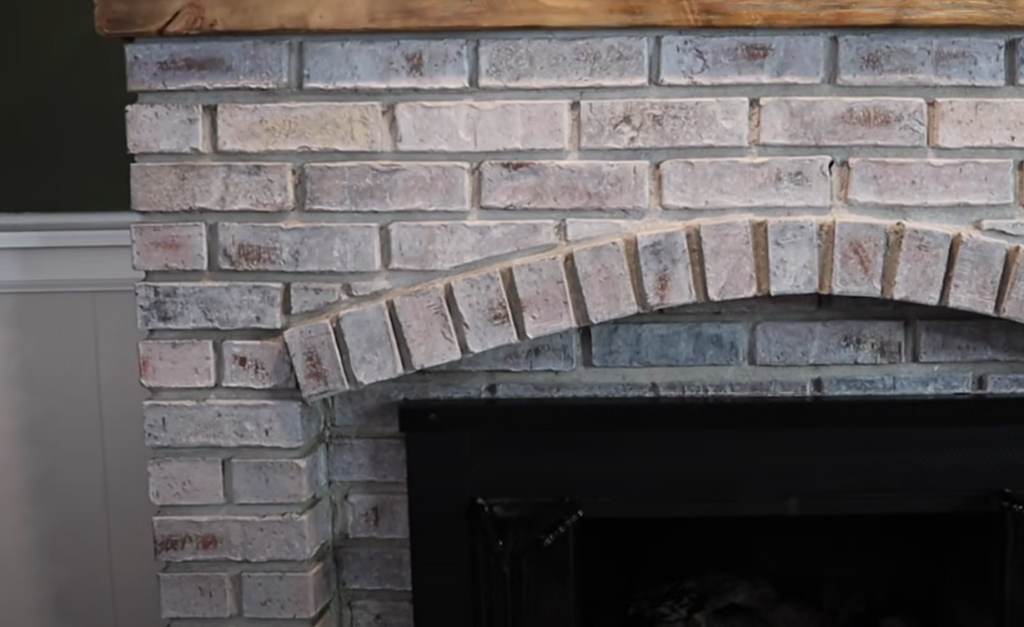
However, there are some drawbacks to the German smear method. One is that it can be difficult to achieve an even coverage with this method. Additionally, this method can be messy and time-consuming.[2]
Limewash
Limewash is a popular choice for whitewashing brick fireplaces because it’s inexpensive and easy to apply.
To apply limewash, start by painting the mortar joints with a brush. Then, use a roller to apply the limewash to the bricks. Work in small sections and don’t forget to get the crevices between the bricks. Once you’ve finished applying the limewash, let it dry for 24 hours before adding a second coat.
Painting vs. Lime Whitewash On A Brick Fireplace
There are two ways to achieve a whitewashed look on your brick fireplace – painting or lime whitewashing. We’ll go over both methods so you can decide which is best for you and your home.
Painting your brick fireplace is the quickest and easiest way to achieve a whitewashed look. All you need is some white paint and a brush or roller and you’re good to go! The downside to painting your fireplace is that it will eventually chip and peel, leaving you with an uneven appearance.
Lime whitewashing is a more labor-intensive process, but it produces a more natural looking finish that will last longer than paint. To lime wash your fireplace, you’ll need to mix hydrated lime with water to create a slurry. Once you’ve mixed the lime and water, you’ll apply it to your fireplace with a brush or roller.
Once you’ve applied the lime wash to your fireplace, you’ll need to let it dry for 24 hours before lighting a fire. And that’s it! You now have a beautiful whitewashed brick fireplace that will last for years to come.[3]
Which finish lasts longer?
Paint can last for years if it’s done right and the bricks are in good condition. Whitewash will only last a year or two before it needs to be redone.
Whitewashing is a great way to update an old fireplace without having to paint it. It’s also much less expensive than painting, so if you’re on a budget, whitewashing is a great option.[3]
How to Choose a Whitewash Brick Fireplace Color
There are a few things to keep in mind when choosing a whitewash brick fireplace color. First, consider the overall style of your home. If you have a more traditional decor, you might want to choose a white or off-white shade. However, if your home has a more modern feel, you could go with a brighter white or even a light pastel color. Second, Consider the colors of the bricks themselves. If they are already fairly light in color, you might want to choose a lighter shade of whitewash so that it doesn’t look too harsh. Conversely, if the bricks are darker, you can go with a slightly darker shade to help them stand out more. Lastly , think about what kind of effect you want to create. If you want a more subtle look, you might want to choose a sheer whitewash. However, if you’re looking for something more dramatic, you could go with a thicker, opaque whitewash.
Learn To Whitewash Brick With Latex Paint & Glaze
Whitewashing brick is an easy and inexpensive way to update a room. You can use latex paint and glaze to create a whitewashed look on your fireplace that will brighten up the space. Follow these steps to get started:
- Start by cleaning the brick with trisodium phosphate (TSP) solution. This will remove any soot or dirt from the surface of the brick.
- Next, mix together equal parts latex paint and glaze. Add water to thin the mixture if necessary.
- Apply the mixture to the brick using a brush or roller, working in small sections at a time.
- Allow the mixture to dry for several hours before repeating the process until you achieve the desired look.
Secret Ingredient To Perfectly Whitewashed Fireplaces
The biggest secret to perfectly whitewashed fireplaces is patience. You can’t rush the process, or you’ll end up with an uneven, streaky finish. It’s important to take your time and work in small sections so that you can get a nice even coat of paint on the bricks.
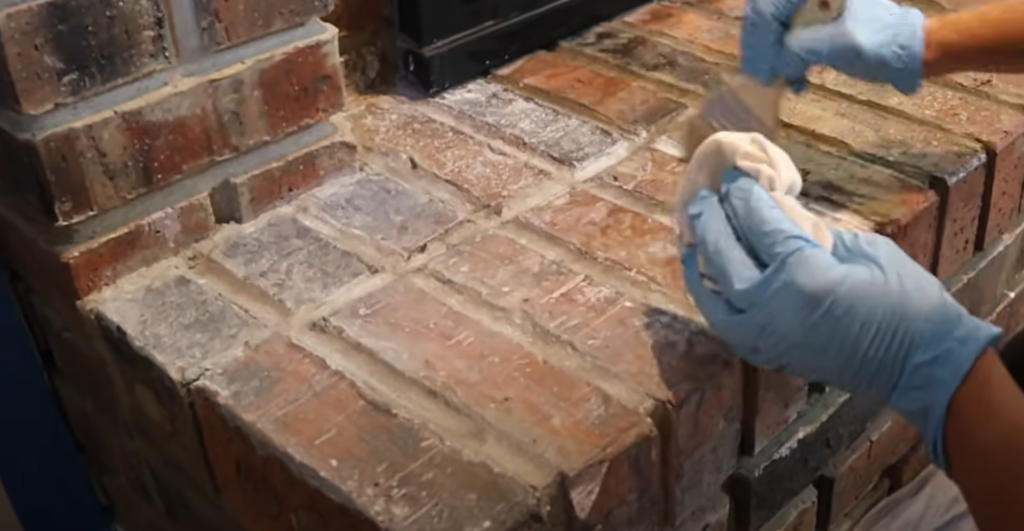
Another important tip is to use a good quality paintbrush. A cheap brush will leave streaks and bristles behind, so it’s worth investing in a good one. Also, make sure to use a primer before painting your fireplace. This will help the paint adhere better to the bricks and prevent it from chipping or flaking off over time.
How Do You Make A Brick Fireplace Look Modern?
If your home has a brick fireplace and you’re looking for ways to modernize it, whitewashing is a great option. By painting the bricks with a white or light-colored paint, you can brighten up the space and make it feel more contemporary. Plus, whitewashing is a fairly simple DIY project that doesn’t require any special skills or tools. In this complete guide, we’ll show you how to whitewash a brick fireplace step by step.
Comparison of Whitewashing Methods for Brick Fireplaces
Whitewashing a brick fireplace can give your home a fresh and timeless look. Below is a comparison of various methods for whitewashing brick fireplaces.
| Method | Materials Needed | Time Required | Cost (Average) |
|---|---|---|---|
| Traditional Whitewash | Lime, Water, Paintbrush | 1-2 days | $50 – $100 |
| Painted Whitewash | Paint, Water, Paintbrush/Roller | 1-2 days | $100 – $200 |
| German Schmear | Concrete Mix, Water, Trowel | 2-3 days | $150 – $300 |
| Limewash Paint | Limewash Paint, Water, Paintbrush/Roller | 1-2 days | $100 – $200 |
Explanation of the table:
- The table compares different methods for whitewashing a brick fireplace based on four key indicators: method, materials needed, time required, and average cost.
- Whitewashing methods include Traditional Whitewash, Painted Whitewash, German Schmear, and Limewash Paint.
- Materials needed indicate the primary supplies required for each method.
- Time required provides an estimate of how long it typically takes to complete the whitewashing process for each method.
- Average cost ranges from the lower to upper estimates for implementing each whitewashing method.
FAQ
What kind of paint do you use to whitewash a brick fireplace?
You will need to use a paint that is specifically designed for brick fireplaces. You can find this type of paint at most hardware stores.
Do you need to clean brick before whitewashing?
Yes, you need to make sure your bricks are clean before you start painting them. You can do this by scrubbing them with a wire brush or using a power washer. If you’re using a power washer, be careful not to damage the bricks.
Once your bricks are clean, let them dry completely before you start painting.
Is whitewashing brick a good idea?
Yes, whitewashing brick is definitely a good idea! There are many benefits to whitewashing your brick fireplace. For one, it will brighten up the space and make it feel more inviting. It can also help to reflect light better, making the room appear larger. Whitewashing brick can also give an old fireplace a fresh new look.
Is it better to whitewash or paint a brick fireplace?
This is a common question with no easy answer. It depends on a variety of factors, including the style of your home, the look you’re going for, and whether or not you’re planning to sell your house in the near future.
Is whitewashing brick out of style?
Whitewashing brick is definitely not out of style. In fact, it’s becoming more and more popular as people are looking for ways to update their older homes without breaking the bank. Whitewashing brick is a great way to give your fireplace a fresh, new look that will instantly brighten up your space.
How long does whitewash brick last?
Whitewash brick will last for many years if it is properly cared for. Be sure to follow the manufacturer’s instructions for cleaning and maintaining your whitewashed fireplace. With proper care, your whitewashed brick fireplace will be a beautiful focal point in your home for many years to come.
What safety precautions should I take when whitewashing a brick fireplace?
When whitewashing a brick fireplace, ensure proper ventilation by opening windows and using a fan. Wear safety goggles, gloves, and a mask to protect yourself from dust and paint fumes. Cover nearby surfaces and furniture to prevent any accidental spills or splatters. Keep a fire extinguisher nearby, just in case.
What’s the recommended technique for achieving an even whitewash on brick?
To achieve an even whitewash on brick, start by cleaning the brick surface thoroughly. Then, dilute your paint with water to create a semi-transparent whitewash mixture. Apply it using a brush, roller, or spray, and immediately wipe the excess off with a cloth or sponge. Work in small sections to maintain consistency and avoid visible brush marks.
Can I change the color of a whitewashed brick fireplace if I don’t like it later on?
Yes, you can change the color of a whitewashed brick fireplace in the future. Simply repaint it with a different color or remove the whitewash by sanding the surface before applying a new finish.
What type of finish or sealer should I use to protect a whitewashed brick fireplace?
To protect a whitewashed brick fireplace, you can use a clear matte or satin finish sealer designed for masonry surfaces. This will help seal the paint and protect it from stains while maintaining the whitewashed appearance.
Can I whitewash a brick fireplace with a dark or heavily stained surface?
Yes, you can whitewash a brick fireplace with a dark or heavily stained surface. However, it may require extra preparation, such as thorough cleaning and potentially using a bonding primer before applying the whitewash to ensure good adhesion and coverage.
Is it necessary to strip existing paint from a brick fireplace before whitewashing it?
If there is existing paint on the brick fireplace, it’s generally recommended to strip it down to the bare brick before whitewashing. This ensures a more even and authentic whitewash finish.
What is the drying and curing time for a whitewashed brick fireplace?
Drying time for a whitewashed brick fireplace can vary depending on factors like temperature and humidity. Typically, it takes a few hours for the paint to dry to the touch. However, curing, or fully hardening, can take several days to a few weeks, so it’s important to avoid contact until it’s fully cured.
Can I whitewash an outdoor brick fireplace, or is it only suitable for indoor use?
You can whitewash both indoor and outdoor brick fireplaces. However, for outdoor fireplaces, you should use an exterior-grade paint and sealer to withstand the elements and protect against fading and weathering.
Useful Video: HOW TO WHITEWASH A BRICK FIREPLACE | DIY MANTLE
Conclusion
Whitewashing your brick fireplace is a great way to update your home without spending a lot of money. Be sure to follow the manufacturer’s instructions for cleaning and maintaining your whitewashed fireplace. With proper care, your whitewashed brick fireplace will be a beautiful focal point in your home for many years to come. Thanks for reading! I hope this article was helpful. If you have any questions, feel free to leave a comment below and I will do my best to answer them. Have a great day!
References:
- https://www.bobvila.com/articles/how-to-whitewash-brick/
- https://renovatedfaith.com/whitewash-a-brick-fireplace/#nbsp-3
- https://www.ringsend.com/blog/post/how-to-whitewash-a-brick-fireplace-with-limewash


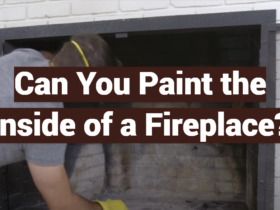


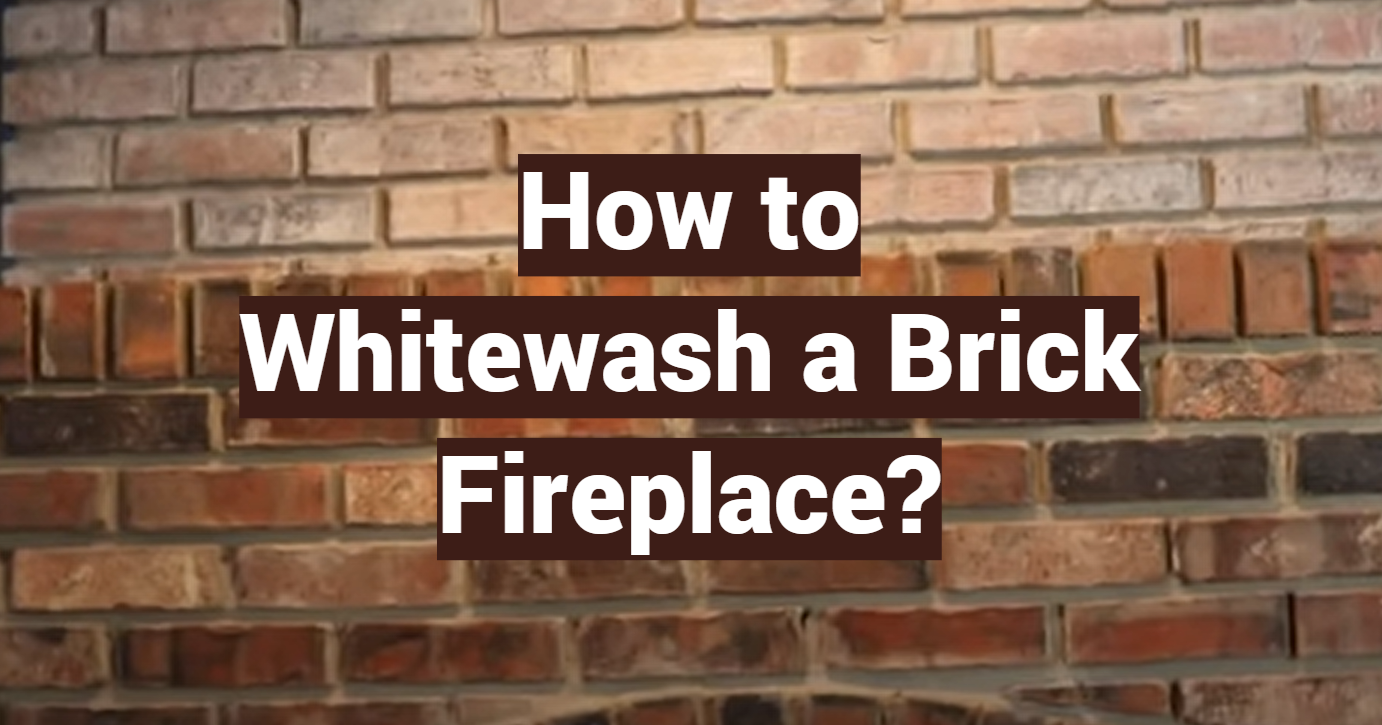








Leave a Review